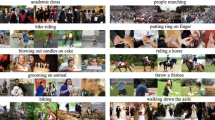Abstract
Semantic categorization for the complex videos is an ambiguous task. The semi-supervised learning method based on hypergraph model can achieve multi-semantics labels, but a hypergraph model is sensitive to the radius parameter when it is constructed and the number of vertices belonging to a hyperedge is fixed. In this paper, a semi-supervised incremental learning method based on adaptive probabilistic hypergraph for video semantic detection is presented. In the probabilistic hypergraph modeling, a formula is presented as a measurement to adaptively decide whether a vertex is belonged to a hyperedge or not. The model has high robustness and can overcome the defect of fixed number of vertices belonging to the same hyperedge in the traditional probabilistic hypergraph model. In the semi-supervised incremental learning process, a threshold is defined, which is used to judge whether unlabeled sample can be added into the modeling, in order that the model learning result for unlabeled samples has high certainty. The experimental results show that our method can improve the model generalization ability and utilize the unlabeled samples effectively. In the aspects of recall rate and precision rate for semantic video concept detection from complex videos, our proposed method outperforms the compared methods.




Similar content being viewed by others
References
Ayers D, Shah M (2001) Monitoring human behavior from video taken in an office environment. Image Vis Comput 19(12):833–846
Chien JT, Wu MS (2008) Adaptive Bayesian latent semantic analysis. IEEE Trans Audio, Speech Lang Process 16(1):198–207
Chou TC, Chen MC (2008) Using incremental PLSI for threshold-resilient online event analysis. IEEE Trans Knowl Data Eng 20(3):289–299
Duan XH, Lin L, Chao HY (2013) Discovering video shot categories by unsupervised stochastic graph partition. IEEE Trans Multimed 15(1):167–180
El-ghazal A, Basir O, Belkasim S (2009) Scale invariants of radial tchebichef moments for shape-based image. IEEE Computer Society Press, New York, pp 318–323, Retrieval//Proceedings of the 11th International Symposium on Multimedia
Fu YW, Guo YW, Zhu YS (2010) Multi-view video summarization. IEEE Trans Multimed 12(7):717–729
Guo PF, Wang XZ, Han YS (2010) The enhanced genetic algorithms for the optimization design. Proceedings of the 3rd International Conference on Biomedical Engineering and Informatics. IEEE Comput Soc Press, New York, pp 2990–2994
Han YH, Shao J, Wu F, Wei BG (2010) Multiple hypergraph ranking for video concept detection. J Zhejiang Univ Sci C (Comput Electron) 11(7):525–537
Huang YC, Liu QS, Lv FJ, Gong YH, Metaxas DN (2011) Unsupervised image categorization by hypergraph partition. IEEE Trans Pattern Anal Mach Intell 3(6):1266–1273
Huang YC, Liu QS, Zhang ST, Metaxas DN (2010) Image retrieval via probabilistic hypergraph ranking. Proceeding of the IEEE Computer Society Conference on Computer Vision and Pattern Recognition, San Francisco, USA, pp 3376–3383
Li XH, Zhan YZ, Ke J, Zheng HW (2011) Shot retrieval based on fuzzy evolutionary aiNet and hybrid features. Comput Human Behav 27(5):1571–1578
Lin L, Gong HF, Li L, Wang L (2009) Semantic event representation and recognition using syntactic attribute graph grammar. Pattern Recogn Lett 30(2):180–186
Liu YN, Chen YH, Zhu L (2011) Tensor-based video categorization via sparse representation. Adv Inf Sci Serv Sci 3(8):8–15
Liu QS, Huang YC, Metaxas DN (2011) Hypergraph with sampling for image retrieval. Pattern Recogn 44(10/11):2255–2262
Liu HS, Lependu P, Jin R, Dou BJ (2011) A hypergraph-based method for discovering semantically associated itemsets. Proceeding of the 11th IEEE International Conference on Data Mining, Vancouver, Canada, pp. 398–406
Meng T, Shyu ML (2012) Model-driven collaboration and information integration for enhancing video semantic concept detection. Proceeding of the 13th IEEE Conference on Information Reuse Integration, Las Vegas, NV, pp 144–151
Perse M, Kristan M, Kovacic S, Vuckovic G, Pers J (2009) A trajectory-based analysis of coordinated team activity in a basketball game. Comput Vis Image Underst 113(5):612–621
Ren M, Zhan YZ, Pan DY, Sun JY (2012) Semantic detection of video events based on probabilistic hypergraph. J Comput Appl 32(11):3014–3017
Snoek CGM, Worring M, Smeulders AWM (2005) Early versus late fusion in semantic video analysis. Proceedings of the 13th Annual ACM International Conference on Multimedia. ACM Press, New York, pp 399–402
Wang YY, Chen SC, Zhou ZH (2012) New semi-supervised classification method based on modified cluster assumption. IEEE Trans Neural Netw Learn Syst 23(5):689–702
Wang YD, Yan QY, Li KF (2011) Hand vein recognition based on multi-scale LBP and wavelet. Proceedings of the 2011 international conference on wavelet analysis and pattern recognition. IEEE Computer Society Press, New York, pp 214–218
Yu J, Wang M, Tao DC (2012) Adaptive hypergraph learning and its application in image classification. IEEE Trans Image Process 21(7):3263–3272
Zha ZJ, Tao M, Wang JD, Wang ZF, Hua XS (2008) Graph-based semi-supervised learning with multi-label. Proceeding of the IEEE International Conference on Multimedia and Expo, Hannover, Germany, pp 1321–1324
Zhang JW, Wang F, Zhang CS, Gao YL (2009) Efficient multi-label classification with hypergraph regularization. Proceeding of the IEEE Conference on Computer Vision and Pattern Recognition, Washington, DC, pp 1658–1665
Zou YX, Shi GY, Shi H, Zhao H (2011) Traffic incident classification at intersections based on image sequences by HMM/SVM classifiers. Multimed Tools Appl 52:133–145
Acknowledgments
This work is supported by the National Natural Science Foundation of China No. 61170126.
Author information
Authors and Affiliations
Corresponding author
Rights and permissions
About this article
Cite this article
Zhan, Y., Sun, J., Niu, D. et al. A semi-supervised incremental learning method based on adaptive probabilistic hypergraph for video semantic detection. Multimed Tools Appl 74, 5513–5531 (2015). https://doi.org/10.1007/s11042-014-1866-9
Published:
Issue Date:
DOI: https://doi.org/10.1007/s11042-014-1866-9




